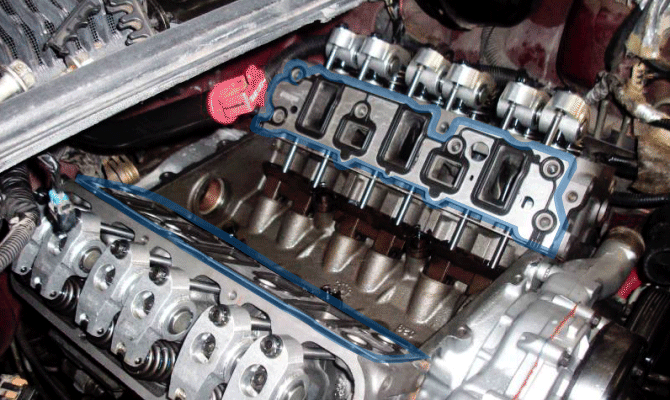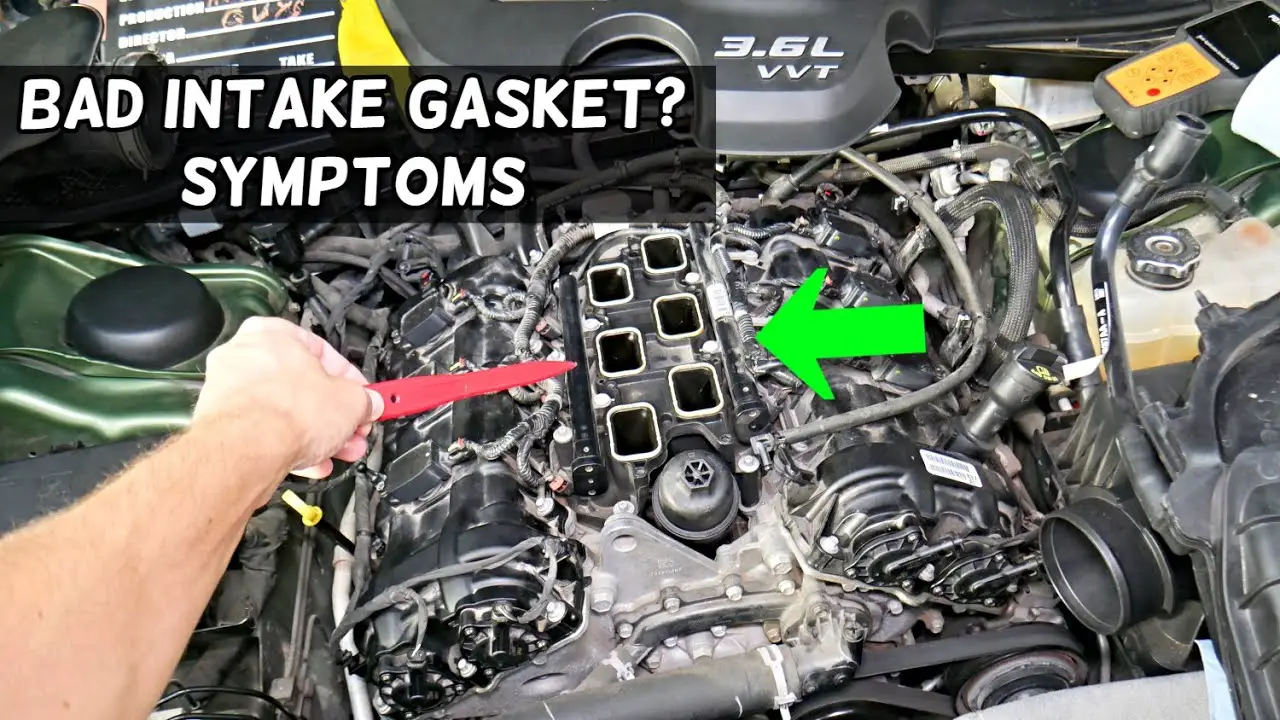Intake manifold gasket leak symptoms include rough idling and decreased engine performance. Detecting these signs early can prevent costly repairs.
A failing intake manifold gasket can lead to various issues, affecting the overall performance of your vehicle. Understanding the symptoms of a leaky gasket is crucial for timely intervention and maintenance. By recognizing intake manifold gasket leak symptoms, you can address the problem promptly, ensuring optimal engine function.

Credit: www.felpro.com
Contents
Intake Manifold Gasket Leak Symptoms
Here are some most common Signs of intake manifold gasket might be leaking
Engine Misfires And Rough Idling
If you notice engine misfires or rough idling, it could be a sign of an intake manifold gasket leak. The gasket plays a crucial role in maintaining proper pressure levels within the intake manifold. When it fails, air leaks can occur, leading to unbalanced air-to-fuel ratios that result in engine misfires and rough idling. These symptoms can indicate a potential issue with the intake manifold gasket.
Coolant Leaks And Overheating
Coolant leaks and overheating are common indicators of a faulty intake manifold gasket. The gasket seals the coolant passages between the intake manifold and the engine block. If it develops a leak, the coolant can escape, leading to visible leaks under the vehicle or in the engine bay. Additionally, a compromised gasket can cause the engine to overheat due to the loss of coolant, signaling a potential intake manifold gasket problem.
.jpg)
Credit: www.ricksautoservice.org
Diagnosing A Leaky Intake Manifold Gasket
If you suspect a leaky intake manifold gasket in your vehicle, it is crucial to diagnose the issue accurately to prevent further damage. Ignoring this problem can lead to decreased engine performance, increased fuel consumption, and potential engine overheating. In this section, we will discuss some effective methods to diagnose a leaky intake manifold gasket.
Visual Inspection Tips
Performing a visual inspection is the first step in diagnosing a leaky intake manifold gasket. By carefully examining the engine area, you may be able to identify some noticeable signs of a gasket leak. Here are some visual inspection tips:
- Look for any visible signs of coolant or oil leakage around the intake manifold area.
- Check for coolant or oil residue on the intake manifold gasket or surrounding components.
- Inspect the intake manifold for any cracks, warping, or damage that could cause a leak.
- Ensure that all intake manifold bolts are properly tightened.
Using A Vacuum Gauge
Another effective method to diagnose a leaky intake manifold gasket is by using a vacuum gauge. This tool measures the intake manifold vacuum and can help identify any irregularities that may indicate a gasket leak. Follow these steps to use a vacuum gauge:
- Connect the vacuum gauge to an easily accessible vacuum port on the intake manifold.
- Start the engine and let it idle.
- Observe the vacuum gauge reading.
- If the vacuum reading fluctuates or drops significantly, it could indicate a leaky intake manifold gasket.
- Inspect the intake manifold gasket and surrounding components for any signs of leakage or damage.
By performing a visual inspection and using a vacuum gauge, you can effectively diagnose a leaky intake manifold gasket. Remember to address this issue promptly to avoid further complications and maintain the optimal performance of your vehicle.
Fixing The Leak: What Are Your Options?
If you suspect that your vehicle’s intake manifold gasket is leaking, it’s important to address the issue promptly to avoid further damage to your engine. Fortunately, there are a few options available to fix the leak, depending on your mechanical skills and the severity of the problem. In this section, we’ll explore two main approaches: DIY gasket replacement and seeking professional help from a mechanic.
Diy Gasket Replacement Guide
If you’re a hands-on individual who enjoys tackling automotive projects, replacing the intake manifold gasket yourself can be a cost-effective option. However, it’s essential to have the necessary tools, technical knowledge, and patience to complete the job successfully.
Here’s a step-by-step guide to help you to replace the gasket:
- Begin by gathering all the required tools, including a socket set, torque wrench, gasket scraper, and a new intake manifold gasket.
- Disconnect the negative battery terminal to ensure safety during the repair.
- Remove the air intake system, throttle body, and any other components that obstruct access to the intake manifold.
- Thoroughly clean the mating surfaces of the intake manifold and cylinder head using a gasket scraper or appropriate cleaning solution.
- Carefully remove the old gasket and clean any residue left behind.
- Position the new intake manifold gasket onto the cylinder head, ensuring proper alignment.
- Reinstall the intake manifold and all the components you previously removed, following the reverse order of removal.
- Finally, torque the intake manifold bolts to the manufacturer’s specifications, using a torque wrench.
When To Call A Professional Mechanic
If you’re not comfortable working on your vehicle or lack the required tools and expertise, it’s wise to enlist the help of a professional mechanic. They have the knowledge and experience to diagnose the issue accurately and ensure a proper repair. Here are a few instances where it’s recommended to call a professional:
- If you’re unsure about the exact cause of the problem or need a comprehensive inspection of your vehicle.
- If you lack the technical knowledge and skills to safely replace the intake manifold gasket.
- If you’re facing time constraints and need a quick and reliable repair.
- If you want to take advantage of the mechanic’s expertise to identify any additional issues that may require attention.

Credit: m.youtube.com
Frequently Asked Questions
Here are some FAQs about intake manifold gasket leak symptoms –
What Happens When An Intake Manifold Gasket Leaks?
When an intake manifold gasket leaks, it can lead to engine misfires, overheating, and a decrease in performance.
What Does A Bad Intake Manifold Gasket Sound Like?
A bad intake manifold gasket can cause a hissing or sucking noise coming from the engine. Additionally, it can also result in poor acceleration, decreased engine power, and overheating. It’s important to have it inspected and repaired promptly to avoid further damage.
How To Test If An Intake Manifold Gasket Is Leaking?
To test if an intake manifold gasket is leaking, you can perform a vacuum test. Connect a vacuum gauge to the intake manifold and start the engine. If the gauge reads below the manufacturer’s specifications, it could indicate a leaking gasket.
Another way is to use a smoke machine to see if smoke is escaping from the gasket area.
How Do I Know If My Intake Or Head Gasket Is Leaking?
Look for white smoke from the exhaust, overheating, or coolant leaks. Check for milky oil or bubbles in the radiator. These are signs of a leaking intake or head gasket. Get a professional inspection for confirmation.
What Are Common Signs Of An Intake Manifold Gasket Leak?
Common signs include rough idling, engine misfires, coolant leaks, and decreased fuel efficiency.
Conclusion
Being aware of intake manifold gasket leak symptoms can save you from costly engine damage. Keep an eye out for signs such as coolant leaks, engine misfires, and high-pitched whistling noises. Addressing these symptoms promptly can prevent further issues and keep your vehicle running smoothly.
Stay informed and proactive!
